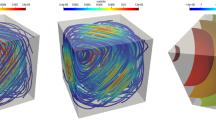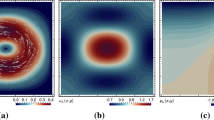Abstract
The aim of this paper is to develop and analyze mixed finite element methods for the Oseen problem using the tensor gradient of velocity as a new unknown. We prove that the new variational formulation and the corresponding Galerkin scheme are well-posed. We also provide optimal order error estimates for the velocity, the pressure, and the gradient of velocity when each row of the velocity gradient is approximated by Raviart–Thomas elements and the velocity and the pressure are approximated by discontinuous piecewise polynomials.
Similar content being viewed by others
References
Apel, T., Knopp, T., Lube, G.: Stabilized finite element methods with anisotropic mesh refinement for the Oseen problem. Appl. Numer. Math. 58, 1830–1843 (2008)
Barrenechea, G. R., Valentin, F.: A residual local projection method for the Oseen equation. Comput. Methods Appl. Mech. Engrg. 199, 1906–1921 (2010)
Barrios, T. P., Cascón, J. M., Gonzaález, M.: Augmented mixed finite element metod for the Oseen Problem: A priori and a posteriori error analyses. Comput. Methods Appl. Mech. Engrg. 313, 216–238 (2017)
Belliveau, S. M.: Analyse d’une méthode d’éléments finis mixte duale avec hybridation pour le problème d’Oseen, Thèse de maîtrise, Université de Moncton, N.B. Canada (2018)
Braak, M., Burman, E., John, V., Lube, G.: Stabilized finite element methods for the generalized Oseen problem. Comput. Methods Appl. Mech. Engrg. 196, 853–866 (2007)
Boffi, D., Brezzi, F., Fortin, M.: Mixed finite element methods and applications. Springer–Verlag, New York (2013)
Brezzi, F., Douglas, J., Duran, R., Fortin, M.: Mixed finite elements for second order elliptic problems in three variables. Numer. Math. 51, 237–250 (1987)
Brezzi, F., Douglas, J., Marini, L. D.: Two families of mixed finite elements for second order elliptic problems. Numer. Math. 47, 217–235 (1985)
Brezzi, F., Fortin, M.: Mixed and hybrid finite element methods. Springer, Berlin (1991)
Brooks, A. N., Hughes, T. J. R.: Streamline upwind/Petrov–Galerkin formulations for convection dominated flows with particular emphasis on the incompressible Navier–Stokes equations. Comput. Methods Appl. Mech. Eng. 267, 199–259 (1982)
Camaño, J., Oyarzúa, R., Tierra, G.: Analysis of an augmented mixed–FEM for the Navier–Stokes problem. Math. Comp. 86, 589–615 (2017)
Ciarlet, P. G.: The finite element method for elleptic problems, North Holland Amsetrdam (1978)
Codina, R.: Analysis of a stabilized finite element approximation of the Oseen equations using orthogonal subscales. Appl. Numer. Math. 58, 264–283 (2008)
Colmenares, E., Gatica, G. N., Oyarzúa, R.: Analysis of an augmented mixed–primal formulation for the stationary Boussinesq problem. Numer. Methods Partial Diff. Equ. 32, 445–478 (2016)
Farhloul, M.: Mixed and nonconforming finite element methods for the Stokes problem. Can. Appl. Math. Quart. 3, 399–418 (1995)
Farhloul, M., Fortin, M.: A new mixed finite element for the Stokes and elasticity problems. SIAM J. Numer. Anal. 30, 971–990 (1993)
Farhloul, M., Fortin, M.: Dual hybrid methods for the elasticity and the Stokes problems : a unified approach. Numer. Math. 76, 419–440 (1997)
Farhloul, M., Fortin, M.: Review and complements on mixed–hybrid finite element methods for fluid flows. J. Comput. Appl. Math. 140, 301–313 (2002)
de Frutos, J., García-Archilla, B., John, V., Novo, J.: Grad-div stabilization for the evolutionary Oseen problem with inf–sup stable finite elements. J. Sci. Comput. 66, 991–1024 (2016)
Girault, V., Raviart, P. -A.: Finite element methods for navier–stokes equations: Theory and algorithms. Springer–Verlag, New York (1986)
Nédélec, J. C.: Mixed finite elements in \(\mathbb {R}^{3}\). Numer. Math. 35, 315–341 (1980)
Raviart, P. -A., Thomas, J. M.: A mixed finite element method for second order elliptic problems. In: Mathematical aspects of the finite element method, (I. Galligani, E. Magenes, eds.), Lectures notes in mathematics, vol. 606. Springer, Berlin (1977)
Author information
Authors and Affiliations
Corresponding author
Additional information
Publisher’s note
Springer Nature remains neutral with regard to jurisdictional claims in published maps and institutional affiliations.
Rights and permissions
About this article
Cite this article
Farhloul, M. Mixed finite element methods for the Oseen problem. Numer Algor 84, 1431–1442 (2020). https://doi.org/10.1007/s11075-020-00879-9
Received:
Accepted:
Published:
Issue Date:
DOI: https://doi.org/10.1007/s11075-020-00879-9




